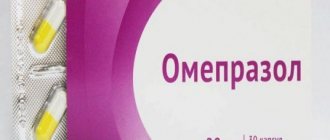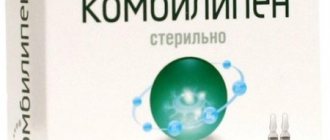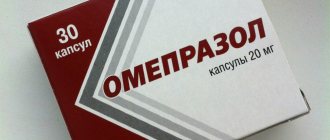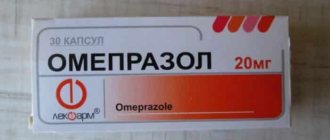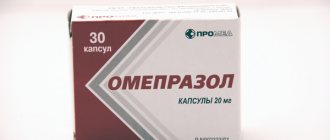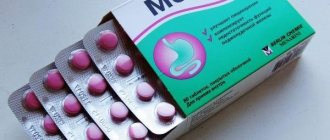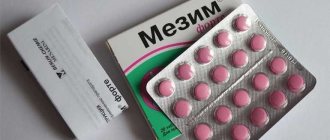According to the instructions, De-Nol is a popular gastroprotective agent. While it provides protection, it is not effective enough alone to cure the disease. The bismuth-containing drug De-Nol with antiulcer effect is produced in the Netherlands in the form of tablets. Promotes a moderate anti-inflammatory effect, reduces acidity, improves the tone of the muscle wall of the stomach, and reduces the activity of Helicobacter pylori infection.
The main property of the medicine is, through the interaction of bismuth salts and mucus proteins, to form a colloidal substance that covers the inner surface of the stomach with a film. Erosions, ulcers, and foci of inflammation are protected from the effects of food and medications. Conditions are created for tissue regeneration, healing, and scar formation.
Antiulcer drugs: joint treatment with De-Nol
For complete treatment of peptic ulcer, drugs with targeted pathogenetic effects are needed. They are prescribed simultaneously with De-Nol, expecting an enhanced joint effect.
Why is complex treatment necessary?
The formation of an ulcer goes through several stages: from hyperacid and erosive gastritis to the formation of a deep defect in the mucous and submucosal layer. In severe cases, the bottom of the ulcer is located on the muscular wall of the stomach. The reasons include the following:
- high acidity with irritating effect and corrosion of own tissues,
- disruption of hormone production (pepsin, gastrin),
- changes in the nervous regulation of muscle tone under the influence of stress,
- unhealthy diet with constant consumption of hard-to-digest foods, spicy seasonings, alcohol, carbonated water,
- focal deterioration of the nutritional conditions (blood supply) of the stomach,
- insufficient mucus production for protection.
As a result, the patient experiences severe attacks of pain in the upper “floor” of the abdomen with irradiation to the back and sides, vomiting mixed with blood, a tendency to diarrhea, heartburn due to reflux (reverse) reflux of acid into the esophagus, belching, and bloating. Dyspeptic symptoms are explained by the entry into the intestines of insufficiently processed and crushed food mass.
To cope with such diverse symptoms, potent drugs are needed, therefore, in the treatment of ulcers, the following are used together:
- antibiotics to suppress and get rid of Helicobacter,
- antibacterial nitro drugs that have a pronounced bacteriostatic effect,
- antacids (acid reducers),
- H2-histamine receptor blockers to reduce the effect of histamine in the inflammatory response,
- painkillers, antispasmodics,
- prokinetic drugs that restore sphincter tone and help stop vomiting,
- stimulators of cell regeneration through increased blood circulation, activation of metabolic processes and immunity,
- sedatives (calming agents).
For each medicine, the doctor selects the optimal dosage, sets the duration of use, takes into account contraindications and compatibility with De-Nol.
The drug "Omeprazole"
The main active component of the drug is omeprazole. Its main function is to reduce the production of aggressive stomach acid. In addition, the medicine prevents the development of various infections. Patients easily tolerate treatment with this drug. An allergic reaction is extremely rare.
"Omeprazole" is prescribed for stomach lesions caused by exposure to acid:
- – stomach ulcer, regardless of the cause of the disease;
- – gastritis (inflammation of the gastric mucosa) at any stage of the disease;
- – Zollinger-Ellison syndrome (benign changes in the pancreas).
The medicine eliminates peptic ulcers that are formed due to the high concentration of acid in the stomach. In addition, the drug effectively fights dyspepsia - relieves pain in the presence of digestive disorders.
Features of joint use of De-Nol and an antiulcer drug
Creating and using the correct combination of drugs with De-Nol requires knowledge of the characteristics of the medication. The doctor should consider the following:
- it is necessary to drink medications, observing a time interval of 40-60 minutes before taking De-Nol, because the metallopeptide coating slows down the absorption of any drugs,
- if the patient is recommended to take antacids (Maalox, Almagel, Gastrofarm), then the effect of bismuth salts decreases,
- other bismuth-containing medications (Vicalin, Bisal, Vikair) should not be co-prescribed; there is a risk of overdose,
- in any treatment regimen, the maximum duration of the De-Nol course of 2 months and the maximum daily dose should be monitored; an increase contributes to the accumulation of bismuth in the blood and the manifestation of toxic properties.
The drug is contraindicated in therapy:
- pediatric patients up to four years of age,
- pregnant and lactating women (transmitted to the fetus, through milk to the child, increases the risk of gene mutations and abnormalities),
- patients with renal failure,
- if hypersensitivity to components is detected.
You can take De-Nol only if you follow the rules:
- take the tablets with water, do not use juices, tea, coffee,
- It is better to exclude milk from dietary dishes, it reduces the effectiveness of bismuth,
- A complete abstinence from alcohol-containing drinks and tinctures is required.
The dosage for adolescents over 12 years of age and adults is 4 tablets per day. You can drink them one at a time 30 minutes before meals, 4 times or 2 twice. Children from four to 8 years old are prescribed 8 mg per kg of weight per day, at 8-12 two tablets.
Among the most mandatory drugs in a comprehensive antiulcer therapy regimen are proton pump blockers. Their action is to suppress the functioning of parietal cells in the synthesis of hydrochloric acid and pepsin. By reducing acidity, bismuth facilitates the formation of a protective film and a bactericidal effect to destroy Helicobacter.
An important feature of all drugs in the group is the ability to “mask” signs of cancerous degeneration. Therefore, before use, the doctor must fully examine the patient to exclude a tumor.
All products are contraindicated during pregnancy and lactation, hypersensitivity. Let's list some of the drugs in the group.
What happens when used together
Omeprazole and De-Nol can be taken together - the drugs have different effects on the functioning of the stomach.
Let's look at what happens when Omeprazole and De Nol are used together:
- Destruction of Helicobacter pylori. Omeprazole creates unfavorable conditions for the life of the microorganism, and De-Nol suppresses the activity of the bacterium and prevents its penetration into the stomach wall. The microorganism with the food bolus enters the alkaline environment of the intestines and is excreted in bulk;
- Protection and regeneration. De Nol forms a protective film on the gastric mucosa and stimulates the process of cell restoration, and Omeprazole suppresses the production of hydrochloric acid, reducing the aggressive effect of gastric juice.
If a gastroenterologist has prescribed you to take De-Nol and Omeprazole, you should not neglect this recommendation. The combined use of medications will more effectively protect the stomach wall and speed up the healing of damage that occurs. It is important to remember that there should be an hour difference between taking medications: first you need to take Omeprozole, after 60 minutes - De-Nol, and then you can eat.
Source: pillsman.org
De-Nol and Omez: how to take together?
Omez is the Indian version of the Russian Omeprazole. Due to its blocking effect on the production of hydrochloric acid, it is prescribed for hyperacid gastritis, reflux esophagitis, and peptic ulcers. It relieves heartburn, belching and pain well.
Available in 20 mg capsules. For ulcers, it is recommended to take one 2-4 times a day. The drug should be taken 30-40 minutes before meals (like De-Nol). This is inconvenient for the patient. You will have to think about the interval between taking medications of 30-40 minutes.
The drug is prohibited for children of any age. Has side symptoms such as:
- headaches and dizziness,
- severe sweating,
- disorders of the nervous system (excitability or depression, insomnia, hallucinations),
- blurred vision,
- abdominal pain with stool upset,
- stomatitis, changes in taste sensations,
- pain and weakness in muscles, joints,
- skin allergies.
Combined use with Omeprazole
Omeprazole can be taken only once a day, regardless of food, so it is much easier to draw up a compatibility scheme for taking De-Nol and Omeprazole. It must be borne in mind that after swallowing the drug begins to act within an hour. The effect lasts for a day. Maximum suppression of secretion occurs after 4 days. It is not recommended to immediately discontinue the drug. An analogue is the drug from Slovenia Ultop, also created on the basis of omeprazole.
After stopping taking it for a week, the secretion level reaches normal. The drug is prescribed in a course of 10 days, regardless of the purpose. During eradication, it creates conditions for other drugs to enhance the effect on the infectious pathogen.
Which drug is better
Many patients are interested in what is best to take in the treatment of gastritis and ulcerative lesions of the gastrointestinal tract? You need to understand that Omeprazole and De-Nol are drugs belonging to different groups, therefore they have different effects on the body. Based on this, it is impossible to replace one drug with another.
In most cases, they are taken together in one course of treatment according to the regimen specified by the doctor, but not at the same time. They combine well and help to cope with the disease faster.
De-Nol and Nexium: rules of therapy
Nexium is produced in Sweden in tablets of 20 and 40 mg and in 5 ml bottles with compressed powder for dilution and solution preparation. The active substance is esomeprazole, its isomer in chemical structure.
The medicine combines well with De-Nol, but it is not prescribed:
- children under 12 years old,
- with fructose intolerance,
- during treatment with Atazanavir and Nelfinavir (specific antiviral drugs used for HIV infection).
It is recommended to use cautiously in severe renal failure and epilepsy, but the conditions are not included in the contraindications. For peptic ulcers, a dose of 20 mg is prescribed 2 times, regardless of food intake, for a course of 7 days.
For the purpose of eradication - 40 mg for a month.
To avoid mixing the drug with other antiulcer drugs, it is convenient to carry out treatment by injection (slowly intramuscularly or by drip). This is a big plus in therapy. The antiepileptic drug Phenytoin does not combine well with Nexium.
Treatment of stomach ulcers with De-Nol
De-nol is an antiulcer drug, which is usually prescribed during an exacerbation and for the purpose of prevention in chronic disease. It contains bismuth subcitrate and exhibits bactericidal, astringent, and hepatoprotective effects.
De-nol for stomach ulcers effectively affects the process of inflammation provoked by the bacterium Helicobacter pylori, and heals erosive defects caused by taking NSAIDs.
Effect of the drug
The drug can be taken to prevent seasonal exacerbations of the disease. It quickly dissolves in the gastrointestinal tract and penetrates into the deeper layers of the mucous membrane, preventing bacteria from multiplying.
Pharmacological treatment of ulcers with Denol has several goals:
- inhibits pathogenic bacterial flora;
- creates a protective film that envelops the walls of the stomach;
- reduces the acidity of gastric juice, normalizes the synthesis of pepsin.
Moreover, even long-term therapy with the drug does not cause resistance of pathogenic microflora, which was recorded through clinical studies. Bismuth subcitrate is able to accumulate in the cellular structure of bacteria and destroy it from the inside.
Combination therapy with De-Nol and Nolpaza
Nolpaza is produced in Slovenia in tablets of 40 and 20 mg. The active substance is pantoprazole, a benzimidazole derivative. The drug belongs to the group of proton pump inhibitors. It is prescribed before meals once a day, so De-Nol and Nolpaza must be “divorced” according to the time of administration. Therapeutic concentration in the blood appears after 2 hours.
Decomposes in the liver. For patients with impaired liver cell function, it is better to choose another drug or adjust the dosage, monitor the tests.
The drug is contraindicated in the following pathologies:
- fructose intolerance,
- severe kidney and liver damage,
- neurogenic dyspepsia.
Caution is required if the peptic ulcer is prone to bleeding and is accompanied by hypovitaminosis B12. In the Helicobacter pylori eradication regimen, 40 mg is recommended in the morning and evening.
Long-familiar Omeprazole
The instructions for the medicine indicate that Omeprazole is a proton pump inhibitor and helps reduce the production of hydrochloric acid.
The medicine is prescribed for the following pathologies:
- Peptic ulcer of the duodenum or stomach. The drug is used to treat exacerbations of the disease or in remission together with other drugs that irritate the gastric mucosa or increase the secretion of the glands;
- Gastritis with high acidity;
- Helicobacter pylori infection. The bacterium actively multiplies in an acidic environment, causing inflammation of the gastric mucosa. A decrease in acidity inhibits the activity of microorganisms, and additional use of antibacterial drugs (Metronidazole) helps destroy the pathogen.
You need to drink Omeprazole or its structural analogue Omez once a day on an empty stomach, with water. Despite the fact that the activity of the medicine is not affected by food intake, it is recommended to eat 30-60 minutes after drinking the capsule.
Taking Rabeprazole
Rabeprazole is a Russian-made proton pump blocker. The active substance is rabeprazole sodium. Available in 10 mg capsules. The drug is completely absorbed after 3.5 hours. The intake does not depend on food; De-Nol and Rabeprazole in the regimen do not interfere with each other. The Indian analogue based on rabeprazole is Khairabezol.
May have side effects:
- decreased appetite, nausea, vomiting, persistent diarrhea or constipation,
- stomatitis,
- bloating,
- dizziness with headache,
- lethargy, drowsiness,
- disturbance of taste and vision,
- temperature increase,
- pain in the back, muscles, joints,
- runny nose, cough, sinusitis,
- allergic skin rash.
Blood tests reveal: increased liver tests, leukopenia, thrombocytopenia. The drug is not used to treat children due to the lack of reliable research results.
Description of the drug "Omez"
The active ingredient is omeprazole (5-methoxy benzimidazole) - the “big brother” of its pharmacological group (belongs to the first generation). The drug is available in the form of capsules (10 and 20 mg) and powder for the preparation of solutions. The drug acts on the exchange of hydrogen ions in the cells enveloping the gastric wall, suppresses their production of hydrochloric acid and enzymes. By leveling the aggressive environment of high acidity, omeprazole, accordingly, reduces damage to mucous membranes throughout the gastrointestinal tract.
The drug may mask the symptoms of serious disorders (for example, tumors), so it is necessary to undergo all necessary studies of the condition of the abdominal organs before starting treatment.
The effect occurs 30-60 minutes after consumption and lasts about a day. Therefore, it is preferable to take the product in the morning before meals or at night.
"Omez" should not be used by nursing women and expectant mothers, as well as by persons with individual intolerance to the components of the drug.
Other antiulcer drugs
In addition to De-Nol and acid production blockers, the following are used in the treatment of peptic ulcers:
- antacids that eliminate acidity by a chemical reaction with magnesium salts, aluminum hydroxide or phosphate, calcium and silicon compounds (Gastratcid, Phosphalugel, Gaviscon, Maalox, Almagel),
- histamine receptor blockers that reduce sensitivity to inflammatory mediators (Ranitidine, Quatemal, Famotidine),
- antibiotics and nitro drugs to suppress Helicobacter pylori infection (Flemoxina Solutab, Tetracycline, Clarithromycin, Azithromycin, Levofloxacin, their nitro drugs Furazolidone, Metronidazole),
- with the help of antispasmodics, pain relief is provided (Platifillin, No-shpa),
- for frequent vomiting and severe nausea, prokinetics are prescribed (Motilium, Cerucal).
After the acute symptoms are relieved, you will need funds to stimulate the healing process (Solcoseryl, Actovegin, vitamin complex, immunocorrectors).
The combination of De-Nol with antiulcer drugs is used to build a complete therapy for the disease. The effectiveness of complex treatment significantly exceeds the minimum prescription. Gastroenterologists explain to patients the benefits of using a combination of drugs and draw up a dosage schedule. The final decision on indications and contraindications can only be made after a complete examination.
2Pharmacological action of drugs in pairs
The drug Omeprazole contains the active ingredient of the same name, and De-Nol contains bismuth tripotassium dicitrate. The drugs are indicated for patients whose diseases are associated with increased acidity of gastric juice. Both medications help eliminate Helicobacter pylori, stop inflammatory processes in the digestive tract, and restore ulcerated defects by regenerating the mucosa. They normalize the level of hydrochloric acid production and reduce its irritating effect on the gastrointestinal tract.
4Contraindications for use
During the treatment period, doctors prohibit drinking alcohol and advise driving with caution. You should not take medications with Vikair, Vikalin, Clopedogrel, Atazanavir due to the development of severe side effects. Taking medications together is contraindicated in the following cases:
- allergy to active or auxiliary components of drugs;
- taking Nelfinavir;
- severe disturbances in the functioning of the kidneys or liver;
- reduced body weight;
- increased fatigue;
- abdominal pain of unknown etiology;
- intoxication of the body;
- disturbance of water and electrolyte balance as a result of prolonged vomiting or diarrhea;
- various swallowing disorders;
- bleeding from the gastrointestinal tract;
- the presence of malignant neoplasms;
- low level of magnesium in the blood;
- reduced supply of vitamin B12;
- osteoporosis.
During pregnancy, it is prohibited to take the product. Breastfeeding should be discontinued before use. For respiratory diseases and persistent heartburn, it is necessary to be under the supervision of a gastroenterologist. If nausea, heartburn, vomiting, allergies in the form of skin rashes, headaches, indigestion or other side effects appear during therapy, treatment is stopped.
Source: gastri.ru
